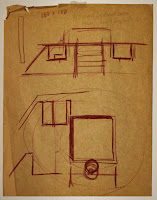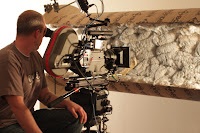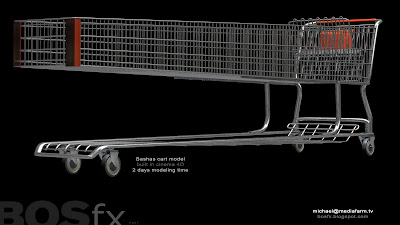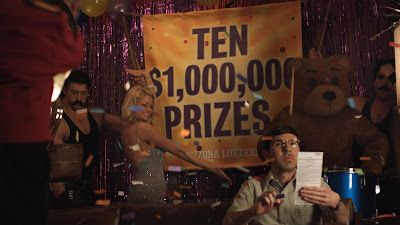I thought it would be fun to share some original concept art (never before seen) from a popular video game project I worked on in the mid 1990s. As a 3D modeler/Surface Artist - It was my job to take hand drawn sketches and turn them into photoreal 3D sets. Softimage was used for all the 3D and Photoshop was used for all texture work. Richard Vander Wende (www.vanderwende.com) and Robyn Miller (www.tinselman.com) were the main designers on the game. Was really the first and last job I had where the goal was to make it look right, no matter how long it took. Well, it took 10 artists almost 4 years to complete all the artwork for the game. As one of those artists, I get asked a lot about the game play - lots of "Myst-Heads" out there. The truth is that I am and have never been much of a video gamer - I have never actually played Riven and don't hold the answers to any of the puzzles. I am letting my 10 year son work all that out - playing Myst on my iPhone and waiting for someone to release the Riven app. It is cool that people still contact me with an interest in what we did - techniques, concepts & technical. Awesome that the game still resonates 15 years later.
So a recent move uncovered a box of sketches and work stuff from my time at Cyan Worlds. There are hundreds of pages of sketches and notes. I randomly grabbed a handful for the first posting. I will post more in the future. Enjoy!
*All images are copyright of Cyan Worlds and should not be used without their consent.
PROJECT OVERVIEW/MAPS
CONCEPT ART/SKETCHES
STUDIO - CYAN WORLDS 1994 - 1997 - Studio layout
Michael Bostick's "Riven" Demo Reel (1994-1997)
Some of my 3D modeling/animation work from the game. All work created with Softimage, Photoshop and Painter. This reel also includes a few personal pieces from the time frame.
Friday, April 16, 2010
Friday, March 12, 2010
mediafarm/bostick 2010 - commercial reel
samples of my commercial work from the past couples of years - 2008 -2010.
*check out additional work at www.mediafarm.tv
toolset:
After Effects, Combustion, Cinema 4D, Final Cut Pro, Dragon Stop & Particle Illusion
*check out additional work at www.mediafarm.tv
toolset:
After Effects, Combustion, Cinema 4D, Final Cut Pro, Dragon Stop & Particle Illusion
Tuesday, February 23, 2010
Casino Arizona "Snack" commercial - visual fx breakdowns
Casino Arizona "Snack"
February 20, 2010
agency: Riester-Phoenix
post house: Blade
fx supervisor: Michael Bostick
compositing: Michael Bostick
color grading: Mark Trengove & Michael Bostick
toolset: 35mm, After Effects, Combustion, Final Cut Pro & Photoshop
production photos - setting up to film the tunnel sequence for one of the two commercials
post production summary:
Casino Arizona recently filmed two new commercials in Phoenix. The spots involve seemingly ordinary situations at home - doing laundry & making a late night snack. The heros are then transported down a wormhole they discover in their dryer and fridge to a fantasy evening at Casino Arizona.
This was the last project I worked on at Blade Editorial. I supervised the fx shoot which took place at a vacant house in North Phoenix. Shot of 35mm, the approach to the visual fx was a combination of practical and digital fx. The props included two 8 ft. long tunnels (open on one side for camera placement), gutted dryer and fridge (actors were pulled thru on a board mounted inside) & false walls in the garage. The glowing light fx that pulses from the appliances were created with practical lights and then enhanced in post & telecine.
The compositing work consisted of a wide shot of the hero entering the fridge. This was accomplished be stitching three different plates. The tunnel shot was constructed with the filmed tunnel prop plate and a live action greenscreen plate (the actors simply laid on a table - hovering off the end). Particle effects were used to give the sense of coldness in the fridge tunnel by adding some breathe to the actor. All the volumetric light effects were created in Photoshop & After Effects. There were also a few signage shots from the casino were Casino Arizona logos were tracked in.
I will post breakdowns once the spot has aired.
thanks to the Riester team for their assistance!
concept to completion: one week
Venomocity - 15 second bumper - animation by Michael Bostick
venomocity.com - check out the link to the venomocity - anti smoking campaign site
Venomocity - 15 second bumper
January 20, 2010
agency/client: Riester-Phoenix
post house: Blade
fx supervisor: Michael Bostick
compositing: Michael Bostick
motion graphics: Michael Bostick
color grading: Mark Trengove
toolset: cinema 4D, After Effects, Combustion & Photoshop
post production summary:
Venomocity is an anti-smoking organization that has a history of really edgy advertising. This 15 second commercial was created to promote a website that allows user to connect via a smart phone - receiving creepy text messages to scare you out of going outside for a smoke. I have always loved the spots from this twisted series and was happy to contribute.
I had one static shot to work with (phone tap) and a bunch of graphic elements, 3D creature stills & 3 days to get it all done. The composite and motion graphics (2.5D segment) were built in After Effects. All the particle layers were constructed in combustion & cinema 4D - rendered & then brought into the composite. The monster effect was done using a stop frame technique - taking one image at a time and repositioning the characters arms & other parts (?) like a digital puppet. Glow and light burst effects were added to finish the look.
thanks to the Riester team for their assistance!
concept to completion: 3 days
Arizona Lottery "Hiding" commercial - visual fx breakdowns
Casino Arizona "Hiding"
July 2, 2009
client: Casino Arizona
post house: Blade
editor/colorist: Mark Trengove
lead compositor: Michael Bostick
matte painter: Michael Bostick
toolset: RED ONE, Final Cut Pro, After Effects, Particular & Photoshop
post production summary:
When Blade won this job we were supposed to just handle the edit and finishing. It quickly became apparent that a lot of compositing work needed to be done. The biggest issue was that the wide establishing shot of the hero coming out of the gas station (last shot of the day) didn't not match the rest of the spot. There were headlights on cars and it was supposed to be middle of the day. In the end, that shot was completely reconstructed - lighting, shadows, set extension, clean up & signage replacement.
Other shots included enhancing the practical confetti that was filmed on set. This was done with Particular in After Effects. There was also considerable clean up done on all those shots as well. Finally, the hero lotto ticket was filmed only in one color. Two colors were needed for variations of the commercial that were being produced. The rotoscoping and color grading for these shots were done in After Effects.
By the time we laid these spots back, almost every shot had some serious compositing work done to it. Whats that phrase?
oh yeah, they can fix it post...
indeed
thanks to the Riester team for their assistance!
concept to completion: one week
Arizona Lottery "Bang for your Buck" commercial - 2010 Addy Award winner
2010 Addy Award Winner
Arizona Lottery "Bang for your Buck"
July 2, 2009
client: Arizona Lottery
agency: Riester-Phoenix
post house: Blade
animation director: Michael Bostick
3D animation: Michael Bostick
stop motion: Michael Bostick
after effects artists: Marco Cardenas & Dylan Kress
storyboard artist: Michael Bostick
color grading: Mark Trengove
audio: Big U
toolset: cinema 4D, After Effects, Photoshop & Stop Motion
final storyboards
production summary:
This was the first full blown animation I had directed in a while. When the Arizona Lottery came to us with the idea of producing a "circus like" world were their Scratcher Tickets would be the animated heroes - I flipped out. I love be giving a challenge that has no initial clear vision. Working with my post team, we came up with an intial storyboard and worked on developing the characters, sets and props that would later become "Lotteryville." I have always been inspired by Terry Gilliam's animation work and wanted to build on that concept with 3D, camera projections & stop frame animation all mixed in.
The team spent about a week in preproduction after which storyboards, style frames and character sheets were presented to the client. They loved the idea and we began the crazy process of assembling all the animation in two weeks. Marco Cardenas and Dylan Kress created several animated characters and props. All this work was either done in After Effects using the puppet tool or photographed cutouts using a stop frame technique. Once these were assembled, they were brought into the 3D master location setups in cinema 4D for final rendering.
I handled all the 3D animation and final compositing. 3D characters included the "Trapeze Scratchers" and the "Quarter Guys" which were animated in cinema 4D.
Final treatment and color were done in After Effects and Final Cut. Mark Trengove of Blade assisted with the final color grading. Final output was at 1080p.
It was cool being the animation director on this one. Little worn out after it was all done, but having total creative freedom made up for that.
thanks to the Riester team for their assistance!
concept to completion: 3 1/2 weeks
Bashas "Cart" commercial - visual fx breakdowns
Bashas "Cart"
agency: Cramer-Krasselt
post house: Blade
fx supervisor: Michael Bostick
director: Mark Trengove
editor: Robb Hoffman
3D animation: Michael Bostick
compositing: Michael Bostick
toolset: cinema 4D, Final Cut Pro, After Effects & Photoshop
post production summary:
When this script hit my desk, the first question posed to me was - "how are we going to do the cart?" This was followed by - "we have one week." Fun! I learned that there was a real 10 foot cart that the client had constructed for some earlier marketing campaigns. After doing some quick math on the overall timing of the commercial, I realized that the real prop would not work. 3D became the only viable option with our timeframe. Mark Trengove directed and shot the plates for the composite on a RED ONE. Robb Hoffman handled the one shot edit, while I prepared the fx plates - rotoscoping & time remapping in After Effects. The 32 ft digital cart was constructed in cinema 4D and rendered with global illumination at 1080p. The total render time for the 10 second animation was 48 hours. The multipass render included a beauty pass, reflection pass, shadow pass, specular pass, diffuse pass & z-depth channel. The final composite was assembled in After Effects and output at 1080p.
Shortly after the commercial aired, I received an email informing me that I was full of $%@# because what I was saying about this commercial on some post was completely wrong. His dad works at Bashas and there is a "REAL CART" that they used for this commercial. Nicest compliment a guy like me could get! Its fun playing on the other side of the smoke and mirrors for a living.
thanks to the C-K team for their assistance!
concept to completion - 5 days
3D model of cart
Monday, February 22, 2010
Arizona Lottery " Celebration" commercial - visual fx breakdowns
Arizona Lottery "Celebration"
April 28, 2009
client: Arizona Lottery
agency: Riester-Phoenix
post house: Blade
editor/colorist: Mark Trengove
fx supervisor: Michael Bostick
lead compositor: Michael Bostick
toolset: RED ONE, Final Cut Pro, After Effects & Photoshop
post production summary:
In 2009 the Arizona Lottery produced "Celebration" to promote the 100 million dollar raffle tickets. This commercial included many wacky characters that invade the hero's home and party down. In preproduction, all the known FX shots were planned out. This included a stitch shot at the end, where the 20 or so actors we would have on set could be multiplied to look like hundreds. We also knew fireworks would be composited in final shot.
I provided supervision to the FX sequences (via phone - I was celebrating Christmas holiday with family in Texas) to my team on set. Everything went great except when it came to the flame thrower. When this guy did his thing it lit up everything around him (most importantly the greenscreen). This made what supposed to be a straight forward composite into frame by frame rotoscope and paint hell. But its this kind of stuff that builds character and wisdom. :)
lesson learned today - be on set... always
thanks to the Blade & Riester team for their assistance!
concept to completion: 2 weeks
fx breakdowns & commercial
Casino Arizona - Life on Easy Street commercial - visual fx breakdowns
fx breakdowns and full commercials
Casino Arizona "Life on Easy Street"
March 20, 2009
client: Casino Arizona
agency: Riester-Phoenix
post house: Blade
fx supervisor: Michael Bostick
editor/colorist: Mark Trengove
lead compositor: Michael Bostick
rotoscoping: Marco Cardenas & Dylan Kress
cel animation: John LeMond
toolset: RED ONE, Final Cut Pro, After Effects & Photoshop
post production summary:
These are two commercials I worked on in 2009 for the Casino Arizona. They involved several cool little gag effects that would play out in this imaginary world where everyone is loaded. I provided FX supervision and all final compositing on the spots. Shot on the RED ONE, the compositing was built at 2k, then down converted to HD. Jon LeMond, formerly of Fox Animation, provided the traditionally hand drawn animation of the "easy street birds." It was really great getting to work with my old friend Jon again. We used to teach in a Film & Animation program together some years back. We took Jon's drawings and then scanned, cleaned & colored the elements and assembled the sequence in After Effects. The dog poop gag was created using a practical effects on set - pushing some magician's flowers up from underneath a greenscreen table setup. Work out really well. We had explored doing the gag in 3D, but it was decided that the look of the prop looked funnier.
There was also a considerable bit of rotoscoping and color work done to make it feel more springtime, not dead of winter in the desert. A lot of paint work had to be done to repair the roof of the house and deal with unwanted window reflection. Even the Easy Street sign at the end was totally repainted - weird reflections & yes, gaffers tape! sweet!
thanks to the Riester team for their assistance!
concept to completion: 3 weeks
production still
easy street birds by Jon LeMond
Subscribe to:
Comments (Atom)

























